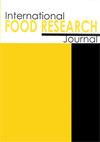Effect of different concentrations of thermoprotectant on microencapsulation of Lactobacillus rhamnosus GG by spray-drying, and its effect on physicochemical properties and viability
IF 0.7
4区 农林科学
Q4 FOOD SCIENCE & TECHNOLOGY
引用次数: 0
Abstract
Lactobacillus rhamnosus GG (LGG) is an acceptable probiotic strain that can live and grow at a gastrointestinal acidic pH and on a bile-rich medium. The influence of spray-drying microencapsulation of LGG on the physicochemical parameters and survivability was investigated in the present work. LGG was spray-dried with three different maltodextrin concentrations (6, 12, and 18% w/v). The inlet and outlet air temperatures of the spray-dryer were kept at 170 ± 5°C and 75 ± 5°C, respectively. The physicochemical parameters (moisture content (wet basis), water activity, and colour), viability (colony forming unit/g), and simulated gastrointestinal digestion were all investigated. Only 18% MD was selected on the basis of moisture content and log CFU/g. The total soluble solids (TSS) of 16.28 ± 0.93 °Brix were obtained using 18% MD. The end product had a moisture content of 5.40 ± 0.20%, and a water activity of 0.32 ± 0.02 aw, which were acceptable. The L*, a*, and b* of the final product were 95.14 ± 0.19, -2.33 ± 0.02, and 7.17 ± 0.13, respectively. The spray-dried powder had final probiotic viability of around 108 CFU/g. Based on the study, maltodextrin at 18% (w/v) concentration can be considered as an ideal formulation with acceptable powder characteristics for shielding probiotic microorganisms from harmful conditions of spray-drying.不同浓度热保护剂对鼠李糖乳杆菌GG喷雾干燥微囊化的影响及其对理化性质和活力的影响
鼠李糖乳杆菌GG (LGG)是一种可接受的益生菌菌株,可以在胃肠道酸性pH值和富含胆汁的培养基上生存和生长。本文研究了喷雾干燥微胶囊化对LGG理化参数和成活能力的影响。用三种不同浓度的麦芽糊精(6、12和18% w/v)喷雾干燥LGG。喷雾干燥机进出口空气温度分别保持在170±5℃和75±5℃。理化参数(水分含量(湿基)、水活度和颜色)、活力(菌落形成单位/g)和模拟胃肠道消化均进行了研究。根据含水率和对数CFU/g,仅选择18% MD。在18% MD下,总可溶性固形物(TSS)为16.28±0.93°Brix。最终产品的水分含量为5.40±0.20%,水活度为0.32±0.02 aw,可接受。最终产物的L*、a*、b*分别为95.14±0.19、-2.33±0.02、7.17±0.13。喷雾干粉的最终益生菌活力约为108 CFU/g。研究表明,18% (w/v)浓度的麦芽糖糊精是一种理想的配方,具有可接受的粉末特性,可以保护益生菌微生物免受喷雾干燥有害条件的影响。
本文章由计算机程序翻译,如有差异,请以英文原文为准。
求助全文
约1分钟内获得全文
求助全文
来源期刊

international food research journal
Agricultural and Biological Sciences-Food Science
CiteScore
1.40
自引率
0.00%
发文量
75
期刊介绍:
The International Food Research Journal (IFRJ) publishes papers in English, six (6) issues a year with the coverage of:
Food Science and Technology
Nutrition and Dietetics
Agriculture, multidisciplinary
Chemistry, multidisciplinary
The scope of the Journal includes:
Food Science, Food Technology and Food Biotechnology
Product Development and Sensory Evaluation
Food Habits, Nutrition, and Health
Food Safety and Quality
Food Chemistry, Food Microbiology, Food Analysis and Testing
Food Engineering
Food Packaging
Food Waste Management
Food Entrepreneur
Food Regulatory
Post-Harvest Food Management
Food Supply Chain Management
Halal Food and Management
 求助内容:
求助内容: 应助结果提醒方式:
应助结果提醒方式:


